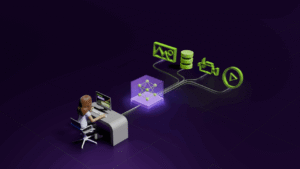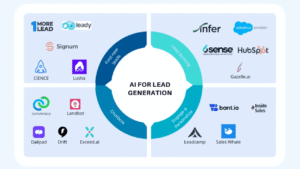As we move into 2025, the integration of AI agents into sales tech stacks has become not just a competitive advantage, but a necessity for companies looking to stay ahead in an increasingly data-driven market. The impact of AI on sales is already evident, with AI-powered chatbots driving a 13X increase in traffic to retail sites during the 2024 holiday season compared to the previous year.
The advent of AI in sales has brought about a paradigm shift in sales operations. From automating routine tasks to providing deep, actionable insights from vast amounts of data, AI agents are empowering sales professionals to work smarter, not harder. These intelligent systems can analyze customer behavior, predict trends, and even engage in personalized communications, all while seamlessly integrating with existing Customer Relationship Management (CRM) systems and other sales tools.
However, the successful adoption of AI in sales is not without its challenges. Many organizations struggle with the complexities of integrating these advanced technologies into their existing workflows and systems. In this comprehensive guide, we’ll provide you with a step-by-step approach to incorporating AI-driven sales intelligence tools into your current tech stack, ensuring a smooth transition and maximizing the benefits of this powerful technology.
Understanding the AI Sales Landscape
Before diving into the integration process, it’s crucial to understand the current state of Artificial Intelligence in sales. Today’s AI sales agents go beyond simple automation—they analyze data, predict customer behavior, and personalize interactions, making sales teams more effective.
AI-powered sales solutions come in various forms, each designed to address specific challenges in the sales process:
“AI agents for sales are intelligent systems that automate and optimize various sales tasks using machine learning, natural language processing, and predictive analytics. They help sales teams improve efficiency, personalize interactions, and close deals faster.”
From lead qualification and customer engagement to forecasting and CRM automation, AI is becoming an essential tool for modern sales teams, helping them work smarter and close deals more efficiently.
Benefits of AI in Sales and Customer Support
1. Lead Generation and Scoring
AI tools in this category identify and qualify potential customers based on behavioral data and predictive analytics. These systems analyze vast amounts of data to prioritize the leads most likely to convert.
Example: Marketo’s AI-enhanced marketing automation platform has significantly improved lead quality for marketers and sales teams. By analyzing engagement and behavioral data, Marketo’s AI more accurately scores lead, ensuring that sales teams receive higher-quality prospects.
2. Sales Intelligence
These systems provide real-time insights on prospects, market trends, and competitive intelligence, enabling sales teams to make data-driven decisions.
Example: LinkedIn’s Sales Navigator leverages AI to analyze user interactions and behaviors, recommending the most relevant prospects. This helps improve pipeline growth, win rates, and reduces the time spent on prospecting.
3. Conversational AI
Chatbots and virtual assistants handle initial customer inquiries and qualify leads, providing 24/7 support and freeing up human agents for more complex tasks.
Example: Zalando’s AI chatbot enhances customer service with natural language processing for human-like responses, predictive analytics for personalized recommendations, and sentiment analysis to adjust tone based on customer mood, ensuring more empathetic interactions.
4. Predictive Analytics
These tools forecast sales outcomes and identify potential opportunities or risks, helping sales teams focus their efforts more effectively.
Example: Salesforce Einstein, an AI-powered CRM tool, has transformed many businesses through its predictive analytics capabilities. U.S. Bank used it for lead scoring, boosting conversions and helping sales teams focus on high-value opportunities, leading to more closed deals.
5. Sales Process Automation
AI that streamlines repetitive tasks allows sales reps to focus on high-value activities, increasing overall productivity and efficiency.
Example: Sembly automates sales processes with AI, extracting insights from conversations, tracking pipelines, and generating documents. It syncs meeting notes and tasks to CRMs, saving time and enabling teams to focus on strategy.
Key Steps to Integrate AI Agents into Your Sales Tech Stack
Step 1: Define Your Objectives and KPIs
The first step in integrating AI agents into your sales tech stack is to clearly define your objectives and key performance indicators (KPIs). This will help you select the right AI tools and measure their impact on your sales process.
- Identify sales challenges: Analyze your current sales process to pinpoint areas where AI can make the most significant impact. Common challenges include lead qualification, response time, and personalized engagement.
- Set clear, measurable goals: Establish specific objectives, such as reducing response time by 50% or increasing lead conversions by 20%.
- Establish KPIs: Define metrics that will help you track progress, such as lead conversion rate, sales-qualified leads (SQLs), and customer satisfaction (CSAT).
Step 2: Assess Your Current Tech Stack
Before introducing new AI tools, it’s essential to evaluate your existing sales technology infrastructure:
- CRM system: Ensure your current CRM can integrate with AI tools. Popular options like Salesforce, HubSpot, and Microsoft Dynamics often have built-in AI capabilities or easy integration options.
- Marketing automation: Assess how your marketing automation platform can work in tandem with AI sales tools to create a seamless lead nurturing process.
- Customer support platforms: Consider how AI can enhance your customer support systems for improved post-sale engagement.
- Data sources: Identify all relevant data sources that can feed into your AI systems, including customer interactions, purchase history, and market data.
Step 3: Choose the Right AI Sales Tools
Selecting the appropriate AI tools is crucial for successful integration. Consider the following factors:
- AI capabilities: Look for tools with machine learning (ML) for adaptability and natural language processing (NLP) for human-like interactions.
- Integration compatibility: Ensure the AI solution can integrate seamlessly with your existing CRM, telephony, and other tools.
- Scalability: Choose tools that can grow with your business and handle increasing data volumes.
- User-friendliness: Opt for solutions with intuitive interfaces to facilitate adoption by your sales team.
- Customization options: Select tools that allow for customization to fit your specific sales processes and industry needs.
Some popular AI sales tools to consider include:
- Salesforce Einstein: Offers AI-powered CRM capabilities, including predictive analytics and automated task management.
- Gong.ai: Provides conversation intelligence and deal analytics to improve sales performance.
- Revenue.io: Specializes in sales workflow automation and AI-powered lead scoring.
- 6Sense: Uses AI to identify prospects ready to buy and create custom messages.
Step 4: Prepare Your Data Infrastructure
AI systems rely heavily on high-quality, well-organized data. To ensure optimal performance:
- Data collection: Gather comprehensive sales data, including historical call logs, customer interactions, and purchase history.
- Data cleaning: Remove duplicates, correct errors, and standardize formats to ensure data consistency.
- Data integration: Set up data pipelines to ensure smooth flow between your CRM, AI tools, and other systems.
- Data security: Implement robust security measures to protect sensitive customer information and comply with data protection regulations.
Step 5: Integration and Deployment
With your objectives set, tools selected, and data prepared, it’s time to integrate the AI agents into your sales tech stack:
- API integration: Utilize APIs provided by your chosen AI tools to connect them with your CRM and other systems. This often involves working with your IT department or a third-party integrator.
- Workflow mapping: Define how the AI tools will fit into your existing sales processes. Create flowcharts to visualize the new workflows.
- Pilot launch: Start with a limited rollout to a specific sales team or customer segment to test the integration and identify any issues.
- Training and onboarding: Provide comprehensive training to your sales team on how to use the new AI tools effectively. This may include hands-on workshops and creating detailed documentation.
- Monitoring and feedback: Closely monitor the performance of the AI agents during the initial deployment. Collect feedback from sales reps and customers to identify areas for improvement.
Step 6: Optimize and Scale
After the initial deployment, focus on continuous improvement and scaling:
- Performance analysis: Regularly review the AI agents’ performance against your established KPIs. Use tools like dashboards and reports to visualize progress.
- Iterative refinement: Based on performance data and feedback, work with your AI provider to refine the models and algorithms.
- Expand use cases: Once you’ve seen success in initial areas, consider expanding the use of AI to other aspects of your sales process, such as upselling or customer retention.
- Cross-functional integration: Look for opportunities to integrate AI insights across other departments, such as marketing and customer service, for a more holistic approach to customer engagement.
Best Practices for Seamless Adoption
To ensure a smooth transition and maximize the benefits of AI in your sales tech stack, consider these best practices:
- Executive sponsorship: Secure buy-in from top management to drive organizational change and allocate necessary resources.
- Change management: Implement a comprehensive change management strategy to address any resistance and ensure smooth adoption across the sales team.
- Continuous learning: Encourage a culture of continuous learning and experimentation with AI tools. Regularly update training materials as new features are introduced.
- Data governance: Establish clear data governance policies to maintain data quality and ensure compliance with regulations like GDPR.
- Ethical considerations: Develop guidelines for the ethical use of Artificial Intelligence in sales, addressing concerns such as data privacy and algorithmic bias.
- Hybrid approach: Maintain a balance between AI automation and human touch. Use AI to augment, not replace, your sales team’s capabilities.
- Regular audits: Conduct periodic audits of your AI systems to ensure they continue to align with your sales objectives and deliver value.
Conclusion
Integrating AI agents into your sales tech stack is a transformative process that can significantly enhance your sales team’s efficiency and effectiveness. By following this step-by-step guide and adhering to best practices, you can ensure a seamless adoption of AI-driven sales intelligence tools.
Remember that the integration of AI into your sales processes is an ongoing journey. As AI technology continues to evolve, stay informed about new developments and be prepared to adapt your strategy accordingly. With the right approach, AI can become a powerful ally in achieving your sales objectives and driving business growth in the increasingly competitive landscape of 2025 and beyond.
Subscribe to Tech-Transformation to stay updated with more such articles getting delivered directly to your inbox!








